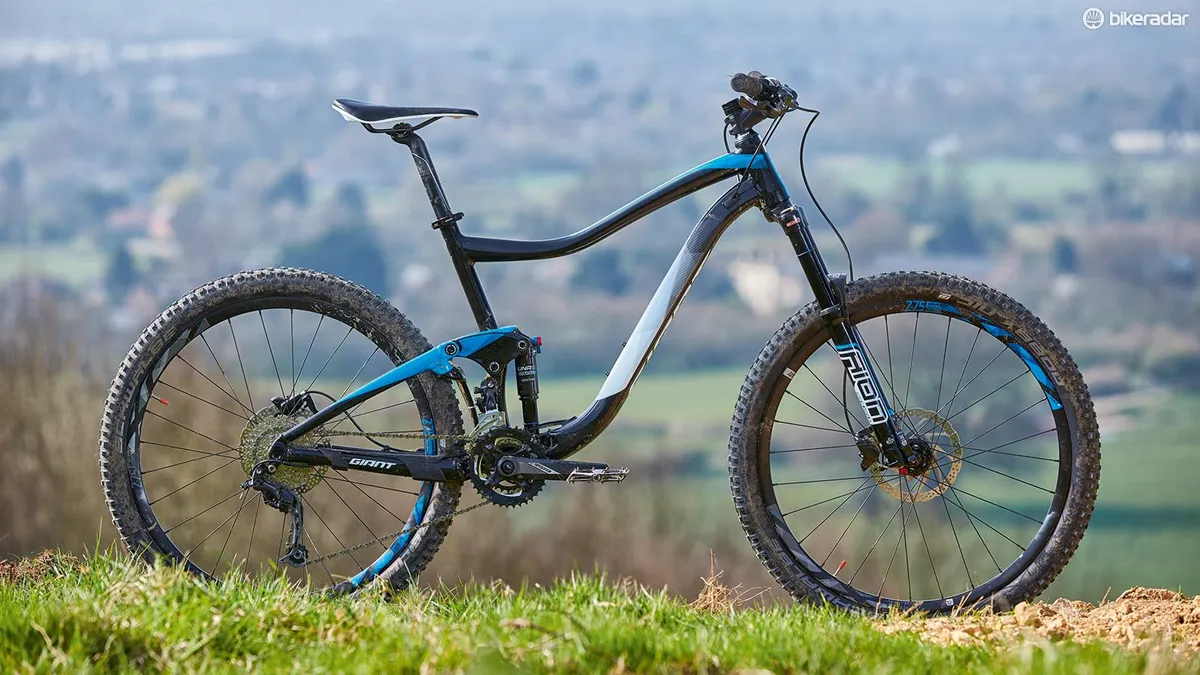Giant’s aluminium frames are always superb quality and the Trance is loaded with sweet detailing, such as fully-sealed internal cable routing, a shared shock and main pivot anchor, and a single-piece carbon linkage. It’s Boost width at the back, too, and offers 140mm of travel.
The components
The Suntour Aion fork has stout 34mm legs and a broad brace, the chunky four-arm spider of the FSA Comet cranks feels stiff underfoot and the 750mm bar is a power steering bonus.
A shorter stem would really ramp up the responsiveness of the front end, but the 75mm stock one strikes a decent balance for climbing and cruising.
The unclamped grips twist in the wet, though, and the plasticky Performance-grade Schwalbe tyres are also sketchy on damp trails.
Obvious casualties of the high frame cost include the low-grade Shimano M315 brakes, nine-speed rear cassette and non-clutch rear mech. Despite there only being two chainrings, our bike had a three-speed left-hand shifter, which didn’t inspire confidence in Giant’s speccing diligence.
Riding the Giant Trance 4
Initially, the Giant feels well sorted. It’s got an OK reach (450mm on the large) and the stiffness of the fork is evident even when you’re rolling round the car park getting used to the self-correcting stability of the 67-degree head angle.
The rigidity of the ‘ALLUX SL’ mainframe, big single-piece carbon linkage and asymmetric-braced swingarm is obvious in every steering and pedal input. There’s impressive wattage transfer, too, thanks to the chunky cranks and broad press-fit bottom bracket shell.
In other words, this state-of-the-art trail chassis feels worth its £1,349 (about $1,809) price if you’re planning a long-term upgrading strategy.
Unfortunately, the stiffness of the frame and fork is part of the problem when it comes to the suspension. While flexier frames flatter crude forks and shocks by adding a bit of structural shock absorption, the Giant makes it all too clear that the Suntour dampers aren’t as smooth as they should be.

The Aion fork is insensitive and clattery over small stuff, and tends to spike and pulp your arms on extended rocky sections. Even with the two pre-installed volume spacers removed and low enough pressure that it dives too deep into the mid stroke, you’ll struggle to get near full travel often, too.
The Unair rear shock is no better. It’s stubborn over small bumps, rocks and roots, but plunges deep into its stroke if you start humping the pedals round. You can reduce that bounce if you get the rebound damping just right, but it’s a fine line between quelling the squelch and constipating the shock.

You certainly wouldn’t think the Trance had the front and rear travel that it does when you’re fighting to stay on line down bouldery descents. The clatter and whip of the chain on the frame makes things even worse, and with no clutch mechanism on the rear mech, the chain is unseated easily, causing pedalling hiccups and misshifts.
While the 180mm rear rotor adds some stopping power, the Shimano brakes are still blunt and uncommunicative, and the lack of suspension connection means the hard tyres struggle even more to find grip.
The overall result is a bike that’s just too harsh and disconnected through its suspension and brakes to let the obvious potential of the frame shine through. Even if you’re after a long-term upgrade project, we’d still push you in the direction of the RockShox-suspended Trance 3 instead, which should be far more controlled and fun.


